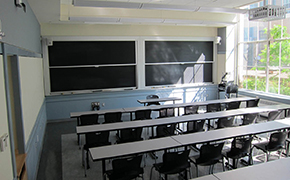Instructor Insights pages are part of the OCW Educator initiative, which seeks to enhance the value of OCW for educators.
Course Overview
This page focuses on the course 8.591J Systems Biology as it was taught by Jeff Gore, Latham Family Career Development Assistant Professor of Physics in Fall 2014.
This course provides an introduction to cellular and population-level systems biology with an emphasis on synthetic biology, modeling of genetic networks, cell-cell interactions, and evolutionary dynamics.
Course Outcomes
Course Goals for Students
- Understand how cells respond to the environment and process information in order to divide.
- Explore how interactions between genes influence the decision-making of cells.
- Examine how interactions between individuals shape how the population behaves in response to environmental pressures.
Jeff Gore, Latham Family Career Development Assistant Professor of Physics (Image by MIT OpenCourseWare).
In the following pages, Professor Jeff Gore describes various aspects of how he teaches 8.591J Systems Biology.
Learn more! In the video at the following Residential Digital Innovations page, Professor Gore explains various techniques he uses to gauge students' understanding of material.
Curriculum Information
Prerequisites
In addition, each weekly problem had a computational problem, so prior experience with a computational package such as MATLAB®, Mathematica®, or Python was expected. The “officially supported” package was be Python (sample code, etc), but students were able to do problems in any language.
Requirements Satisfied
GIR Science Core, Biology
Offered
Every fall semester
Assessment
The students' grades were based on the following activities:
 40% Problem sets
40% Problem sets 5% Pre-class reading questions
5% Pre-class reading questions 15% Midterm #1
15% Midterm #1 15% Midterm #2
15% Midterm #2 25% Final exam
25% Final examStudent Information

Enrollment
Student enrollment was 26 in Fall 2014, and has ranged from 23-35 students in past years.
Breakdown by Year
2/3 graduate, 1/3 undergraduate
Breakdown by Major
1/3 physics, 1/3 biology, 1/3 biological engineering and chemistry
During an average week, students were expected to spend 12 hours on the course, roughly divided as follows:
In Class/Lecture
- Met 2 times per week for 90 minute sessions; 24 sessions total, mandatory attendance.
- In-class activities included multiple-choice concept questions
 and collaborative learning.
and collaborative learning.
Out of Class
- Students were required to submit answers to the pre-class reading questions online, prior to each lecture.
- Students completed weekly problem sets for the course.
Semester Breakdown
| WEEK | M | T | W | Th | F |
|---|---|---|---|---|---|
| 1 |  |  |  |  |  |
| 2 |  |  |  |  |  |
| 3 |  |  |  |  |  |
| 4 |  |  |  |  |  |
| 5 |  |  |  |  |  |
| 6 |  |  |  |  |  |
| 7 |  |  |  |  |  |
| 8 |  |  |  |  |  |
| 9 |  |  |  |  |  |
| 10 |  |  |  |  |  |
| 11 |  |  |  |  |  |
| 12 |  |  |  |  |  |
| 13 |  |  |  |  |  |
| 14 |  |  |  |  |  |
| 15 |  |  |  |  |  |
| 16 |  |  |  |  |  |
 No classes throughout MIT
No classes throughout MIT Lecture session
Lecture session Exam
Exam No class session scheduled
No class session scheduled Assignment due date
Assignment due date

 Room 1 of 1
Room 1 of 1 